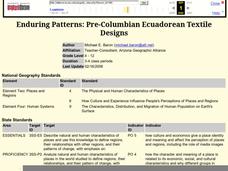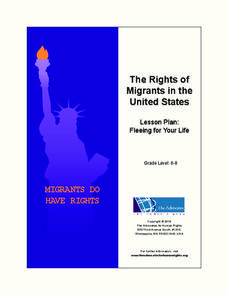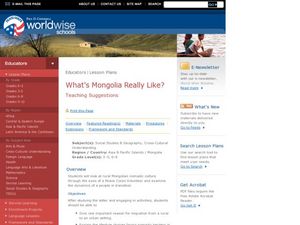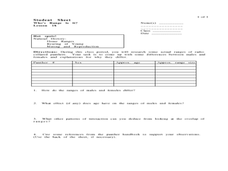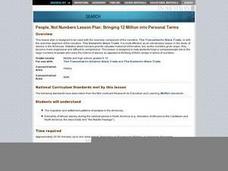Curated OER
Enduring Patterns: Pre-Columbian Ecuadorean Textile Designs
Students examine Pre-Columbian Ecuadorean design motifs. They view examples of the designs, discuss the motif themes, and replicate the designs on modern fabric using authentic methods.
Advocates for Human Rights
The Rights of Migrants in the United States Lesson Plan: Fleeing for Your Life
A role-playing scenario has middle-schoolers imagining that they are refugees forced to flee their community and integrate into a new one. Then, some play the roles of members of the new community and the class brainstorms ideas about...
Curated OER
Going Batty
In this bats worksheet, students read 10 facts about bats. Students also choose the correct words from the box to complete the sentences.
Peace Corps
What's Mongolia Really Like?
Understanding different cultural experiences is a challenging and worthwhile objective throughout grade and content levels. This lesson facilitates an appreciation of rural Mongolian life through a simulation of being a nomadic teen...
Curated OER
What's Mongolia Really Like?
Students discover the people of Mongolia. For this social studies lesson, students look at the Mongolian nomadic culture by reading a letter written by a member of the Peace Corps. They describe the different types of communities found...
Virginia Department of Education
Succession
The final activity in a two-part series prompts scholars to create newspaper articles and succession events. Applying their knowledge of the ecosystem and the past examples of succession, they predict what will happen in the future...
NET Foundation for Television
1850-1874 African American Settlers
Go West, young man! Scholars investigate the impact of African American settlers moving to the Nebraska territory, following the passage of the Kansas-Nebraska Act in the mid 1800s. Using primary sources, timelines, maps, and...
Curated OER
Who's Range is it?
Students investigate the habits of panthers by analyzing radio transmitted data. In this animal life lesson, students utilize computers to view the range of different statistics dealing with Florida panthers. Students...
LABScI
Population Dynamics: The Predator-Prey Lab
Wolves eat better when the bunny population increases, but how long does that last? A series of 12 biology lessons uses the sixth installment to explore the predator-prey relationship between bunny and wolf populations. Young scientists...
American Museum of Natural History
Find My Plankton Baby Picture
Get a better understanding of babies in the sea. The class learns about the two kinds of plankton. They then determine the baby pictures of eight marine animals given a picture of the adult and some hints about the larvae. When scholars...
PBS
Star Power
Let there be light—or maybe not. Pupils learn about light pollution with an investigation of constellations. They create constellation boxes and experiment with different levels of light. Observations are then made about the lighting in...
Curated OER
Haitian Immigration: Twentieth Century
Students read a narrative about the culture, heritage and history of Haiti including the contributions of Haitian immigrants in the U.S. They conduct further research on Haitian culture and prepare a presentation for the class.
Curated OER
Commonalities and Differences from Africa to Cleveland as Evidence Through the Gullah Community Connection
Students explore Afro-American history. They identify the commonality between African, Carolinian and Cleveland Black culture. Students explore the water cycle, oceanography, hydrology and bio-geochemical processes. They discuss the...
Curated OER
People, Not Numbers: Bringing 12 Million into Personal Ter
Students forge a compassionate link to the large numbers of people who were the victims of slavery as opposed to thinking of them simply in terms of numbers. They perform a math exercise to put the number of people in slavery into...
Curated OER
Exploring Ethnic Groups in Africa
Students research the ethnic groups located in African countries where African Americans immigrated. They view a multi-media presentation imbedded in this plan, then construct posters that represent ethnic groups.
Curated OER
Where Do We Go From Here?
Pretending to be freed people, pupils explore the reasons why US citizens might emigrate from the USA to new lands. Within this lesson, they will prepare proposals discussing both the pros and cons for emigration. The lesson will...
Curated OER
Contemporary Immigration Lesson Plan
Students research contemporary immigrations of Africans to the United States. They investigate the laws and regulations of immigration and the impact of immigration on the nation.
Curated OER
Where Should We Land?
Students discuss the difference between major landforms as a class. In groups, they rate the landforms based on the needs of the community that wish to settle there. They also discuss the push and pull factors of the colonists that made...
Curated OER
The Birth of a Rocky Mountain City and Railroad: Georgetown and the Loop Railroad
Learners explore the evolution of a town. In this social studies lesson, students discuss why Georgetown and the Georgetown Loop Railroad were developed and discuss life as a prospector. Learners write a letter explaining what life is...
Curated OER
Alberta And Saskatchwan: the View in 1905
Learners analyze the differences between maps 1905 and current maps of Alberta and Saskatchewan. They use maps from the Canadian Council for Geographic Education to complete a guided inquiry. This lesson also has many extension activities.
Curated OER
Westward Ho: The Difficulties of Emigrants Moving West
Young scholars research the journey west of 19th century emigrants. In this pioneer lesson, students read the letters and diaries of a fictitious family traveling on the Oregon Trail. They mark their route on a US map, create a chart...
Curated OER
A Canadian Inventory: The Way We Are!
Learners, in groups, explore major thematic sections of the Atlas of Canada. They use their findings to produce a wall display, consider and incorporate the issue of sustainability into their material and deliver a presentation to the...
Curated OER
Does Conflict Shape Nations? The Middle East
Students locate settlements and observe patterns in the size and distribution of cities using maps, graphics, and other information. They explain the processes that have caused cities to grow.
Curated OER
Culture Clash: New World Meets Old
Sixth graders explore the history of Christopher Columbus. In this World History activity, 6th graders research facts about Christopher Columbus. Students write their own opinion about Columbus's background focusing on three...
Other popular searches
- Human Migration Patterns
- Early Human Migration
- Human Migration Maps
- Math Human Migration
- Ancient Human Migration
- Human Migration Geography
- Mapping Human Migration
- Human Migration From Ireland
- Human Migration Africa
- Early Human Migration Maps
- Usa Human Migration
- Early Human Migration Routes


